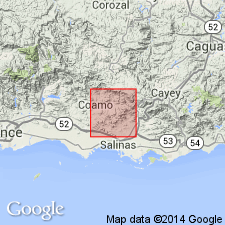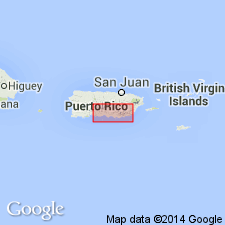
- Usage in publication:
-
- San Diego Lapilli Tuff Member*
- Modifications:
-
- Named
- Dominant lithology:
-
- Tuff
Summary:
The San Diego Lapilli Tuff Member of the Coamo Formation, here named, consists of greenish-weathering tuff breccia composed of angular fragments of pyroxene in a matrix of fine-grained chloritized material. Conformably overlies the Cariblanco Formation; underlies the Santa Ana Limestone Member or siltstone and sandstone of the Coamo. Thickness ranges from 125 to 225 m. Age is Late Cretaceous.
Source: GNU records (USGS DDS-6; Reston GNULEX).

- Usage in publication:
-
- San Diego Member*
- Modifications:
-
- Revised
Summary:
In the Coamo area the Maravillas Formation includes the basal Sabana Hoyos Limestone Member, reassigned from the underlying Cariblanco Formation, the San Diego Member, here redefined from Tuff Member to Member because the term "lapilli tuff" is not uniformly appropriate, the Santa Ana Limestone Member, reassigned to the Maravillas Formation from the overlying Coamo Formation, and younger unnamed map units of mudstone, pyroclastic rocks, limestone, and conglomerate.
Source: GNU records (USGS DDS-6; Reston GNULEX).
For more information, please contact Nancy Stamm, Geologic Names Committee Secretary.
Asterisk (*) indicates published by U.S. Geological Survey authors.
"No current usage" (†) implies that a name has been abandoned or has fallen into disuse. Former usage and, if known, replacement name given in parentheses ( ).
Slash (/) indicates name conflicts with nomenclatural guidelines (CSN, 1933; ACSN, 1961, 1970; NACSN, 1983, 2005, 2021). May be explained within brackets ([ ]).

